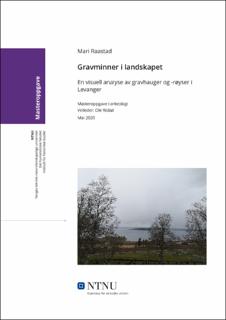| dc.contributor.advisor | Risbøl, Ole | |
| dc.contributor.author | Raastad, Mari | |
| dc.date.accessioned | 2021-09-13T16:04:48Z | |
| dc.date.available | 2021-09-13T16:04:48Z | |
| dc.date.issued | 2020 | |
| dc.identifier | no.ntnu:inspera:58319055:9432674 | |
| dc.identifier.uri | https://hdl.handle.net/11250/2775580 | |
| dc.description.abstract | I denne oppgaven blir det sett på gravminnenes plassering i landskapet, hvor bronsealderens og jernalderens gravminner i Levanger blir studert. Gravminnene i Levanger har forskjellig plassering i landskapet og ulik henvendelse til landskapet rundt. Gjennom dette kan vi komme nærmere en forståelse av bruken av det forhistoriske landskapet. Plasseringen i landskapet og henvendelsen til landskapet rundt, andre kulturminner og ferdselslinjer kan belyse gravminnenes landskapskontekst og mulige intensjoner bak plasseringen. Gravminner kan også fortelle noe om samfunnsorganiseringen i bronsealderen og jernalderen. Dette er noe av det som har blitt sett på i oppgaven.
For å undersøke gravminnenes plassering i landskapet ble det sett på hvordan gravminnene henvender seg til andre kulturminner og veistruktur fra historiske kart. Dette ble gjennomført med å utføre synsfelt i ArcMap for hvert enkelt gravminne og bruk av visuell landskapsanalyse. For å gjennomføre synsfeltanalysene trengs det terrengmodeller. Disse har blitt generert ved å bruke lidardata. For analysen ble det gjennomført synsfelt på 403 gravhauger og – røyser. Innsynet til gravminnene fra enkelte strekninger fra veistrukturen fra de historiske kartene og punkter fra Trondheimsfjorden ble også undersøkt.
Resultatene av analysen viser at gravhaugenes og -røysenes plassering i landskapet kan ha en sammensatt betydning. Gravhaugene og -røysene er plassert i landskapet slik at de skal bli sett. Flere gravminner er plassert at de har en tilknytning til blant annet jordbruk og ferdselslinjer. Basert på innsynet og utsynet til gravminnene, relasjoner til andre kulturminner og ferdselslinjer kan det pekes på mulige intensjoner bak plasseringen i landskapet. Blant mulige intensjoner har det det blitt trukket fram bruken som seilingsmarkeringer, territoriemarkeringer eller som et uttrykk for det kosmologiske og rituelle landskapet. Gravminnenes tilknytning til gode jordbruksforhold og en plassering ved viktige ferdselslinjer, sammen med andre ressurser kan peke på samfunnsorganiseringen i bronsealderen og jernalderen. Dette kan danne et grunnlag for velstand og økonomisk overskudd for flere gårder. | |
| dc.description.abstract | This thesis examines the placement of burial monuments in the landscape, where the Bronze and Iron Age burial monuments in Levanger are studied. The burial monuments in Levanger have different placement in the landscape and relate to the surrounding landscape differently. Through this we can gain a closer understanding of the use of the prehistoric landscape. The placement in the landscape and the possible relations to the surrounding landscape, other archaeological sites, and movement lines can clarify the landscape context and possible intensions behind the placement of the burial monuments. The burial monuments can also tell something about the organization of the society in the Bronze and Iron age. This is something that have been looked at in the thesis.
For the study of the placement of the burial monuments in the landscape, it was looked at how the burial monuments relates to other archaeological sites and road structure from historical maps. This was accomplished by executing viewshed for each individual burial monument in ArcMap and the use of visual landscape analysis. Terrain models are needed to execute viewshed analysis. These have been generated using lidar data. For the analysis, it was conducted viewshed on 403 burial mounds and -cairns. Visibility from different sections of the road structure from the historical maps and points from Trondheimsfjorden were examined.
The results of the analysis show that the placement of the burial mounds and -cairns might have a versatile significance in the landscape. In the landscape the burial mounds and -cairns are placed where they can be seen. Several burial monuments are placed where they have a relation to areas of agriculture and movement lines. Based on the visibility to and from the burial monuments, the relation to other archaeological sites and movement lines, it is possible to point out potential intentions behind the placement in the landscape. Potential intensions that have been highlighted in the thesis are the function of the burial monuments as sailing markings, territorial markings or as an expression for the cosmological and ritual landscape. The burial monuments connection to good agricultural conditions and a placement along important movement lines, together with other resources, may point to something about the social organization in the Bronze and Iron Age. This can form the basis for prosperity and economical surplus for several farms. | |
| dc.language | | |
| dc.publisher | NTNU | |
| dc.title | Gravminner i landskapet - en visuell analyse av gravhauger og - røyser i Levanger | |
| dc.type | Master thesis | |
